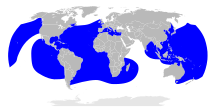Leatherback sea turtle
The leatherback sea turtle is the largest of all living sea turtles. It is the fourth largest modern reptile behind three crocodilians.[5][6]
| Leatherback sea turtle Temporal range: Holocene | |
|---|---|
 | |
| Scientific classification | |
| Domain: | Eukaryota |
| Kingdom: | Animalia |
| Phylum: | Chordata |
| Class: | Reptilia |
| Order: | Testudines |
| Suborder: | Cryptodira |
| Superfamily: | Chelonioidea |
| Family: | Dermochelyidae |
| Subfamily: | Dermochelyinae |
| Genus: | Dermochelys Blainville, 1816[3] |
| Species: | D. coriacea |
| Binomial name | |
| Dermochelys coriacea (Vandelli, 1761)[3] | |
 | |
| Synonyms[4] | |
List of synonyms
| |

Adults average 1–1.75 metres (3.3–5.7 ft) in shell length, 1.83–2.2 metres (6.0–7.2 ft) in total length and weigh 250 to 700 kilograms (550 to 1,540 lb).[7][8] The largest ever found was over 3 metres (9.8 ft) from head to tail and weighed 916 kilograms (2,019 lb).[9] It was found on a beach on the west coast of Wales.[10]
The eggs and young are often eaten by predators, but the adults can defend themselves aggressively. Only the largest sea predators can tackle a leatherback successfully.[11]
Leatherback turtles are one of the deepest diving marine animals. They have been recorded diving to depths as great as 1,280 metres (4,200 ft).[12]
They are also the fastest-moving reptiles. The 1992 edition of the Guinness Book of World Records lists the leatherback turtle moving at 35.28 kilometres per hour (21.92 mph) in the water.[13][14]Usually, they swim at 0.5–2.8 metres per second (1.1–6.3 mph).[15]
They can live as far north as Alaska and Norway and as far south as the Cape of Good Hope in Africa and the southernmost tip of New Zealand.[7] The leatherback is found in all tropical and subtropical oceans, and it also goes well into the Arctic Circle.[16]
Very little is known about how long they live. Some reports say "30 years or more",[17] while others say "50 years or more".[18]

